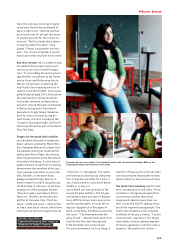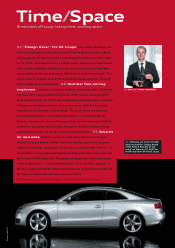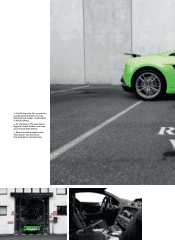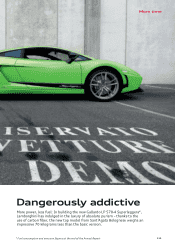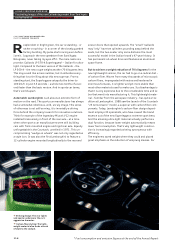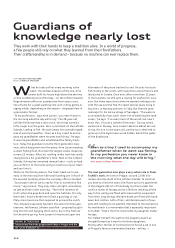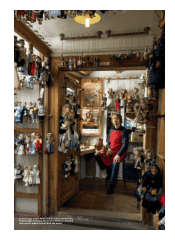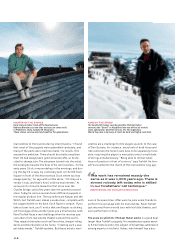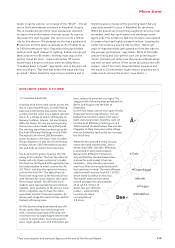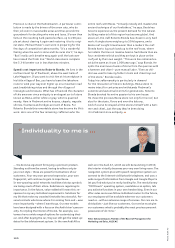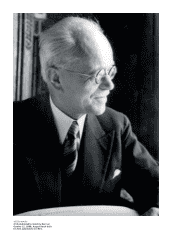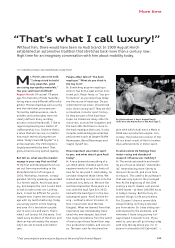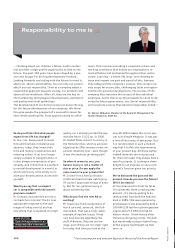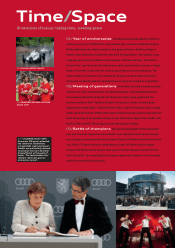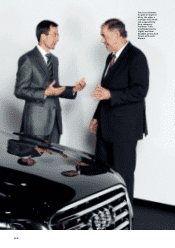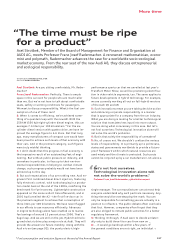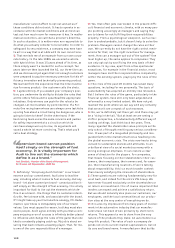Audi 2009 Annual Report Download - page 122
Download and view the complete annual report
Please find page 122 of the 2009 Audi annual report below. You can navigate through the pages in the report by either clicking on the pages listed below, or by using the keyword search tool below to find specific information within the annual report.
COPY/SUSANNE STEININGER
A strong wind drives dark clouds across the
sky. It’s pouring with rain. A small fishing
boat casts off into the bay, where the sea
crashes into the rocks. It’s a typical late fall
day in Å, a village of about 100 people on
Norway’s Lofoten Islands. Yet one thing is
different today. 20 cars are moving along
the narrow coastal roads along the fjords:
The starting signal has just been given for
the Audi Efficiency Challenge A to B 2009.
The object is to drive 4,182 kilometers
across Europe in nine days. From Å to Bee.
The participants on this tour from Norway
to Italy include 120 international journal-
ists and Audi customers from Germany.
The Audi brand’s goal is to prove the effi-
ciency of its vehicles. The tour therefore in-
cludes not only those versions of a model
line that are configured with especially low
fuel consumption in mind, such as the A4
2.0 TDI e*, but also the sportiest versions,
such as the Audi S4*. The objective is to
finish each stage not as the fastest car but
with the best fuel consumption (at a speci-
fied average speed). Ten different Audi
models, each represented by two identical
vehicles, were available to the drivers. Each
driver’s objective was to beat the other,
equivalent vehicle’s fuel consumption. So
during each stage the teams of two vied for
the best efficiency score.
On this journey they encountered very dif-
ferent roads: After the ride through the
wild, romantic landscape of Norway, the
road from Oslo to Copenhagen seemed like
a return to civilization: four-lane express-
ways, legal speeds over 100 kilometers per
hour, industrial areas left and right. The
stages on the following days proceeded via
Berlin and Prague into the Alps to
Kitzbühel.
On the last stage, nature once again finally
displayed its full magnificence. The sun
bathed the mountain peaks in its warm
light. Autumnal colors lined the road. At
last the Audi Efficiency Challenge A to B
2009 reached its destination: Bee on Lake
Maggiore in Italy. Everyone in the village
was out lining the road as the cars crossed
the finish line.
What the tour proved on hilly country
roads and rapid expressways, and in
dense city traffic, was this: Efficiency
is standard in every Audi product.
Because the different models not
only verified the standardized values
claimed for each model’s fuel con-
sumption – they actually consumed
even less when driven specifically with
fuel economy in mind. The most efficient
vehicle overall was the Audi A3 1.6 TDI*,
which made its debut on this tour.
This model achieved the lowest
overall average fuel consumption
of all with 3.3 liters of
diesel fuel per 100 kilo-
meters – substantially
less than its rated
consumption of
3.8 liters.
More time
119
torate in sports science, is in charge of the “Streif” – the ski
run on the Hahnenkamm mountain in Kitzbühel, Austria.
This is considered one of the most spectacular downhill
courses in the entire history of winter sports. As soon as
they leave the starting gate, this race turns into a hellish
ride for the ski pros: The steepest section has a gradient of
85 percent, and the skiers accelerate as if in freefall to up
to 140 kilometers per hour. They whizz through wooded
sections with rapid changes in lighting. Sudden bumps get
them airborne for 80 meters. Yet they must stay on the
perfect line at all costs – mere centimeters off course
would mean a head-on collision with the safety fence.
“I’ve skied down it myself,” says Huber, who is 44 years old,
with a brief grin. “But that was before the slope was fully
groomed.” Huber heads the organizing committee and is
therefore also in charge of the grooming team that pre-
pares this downhill course in Kitzbühel for the skiers.
When his people set to work they augment the snow cover
as needed, and they squirt water into the deeper snow
layers under the surface so that the moisture rises upward
to create a hard and highly resistant surface. Creating the
perfect ski slope is a science like no other. “We’ve got
years of experience that gets passed on from the older to
the younger generations,” says Huber. Skills of the trade,
precise timing and inch-perfect work are prime require-
ments. His team can determine the precise altitude above
sea level on each section of the course by using a new GPS
system. “And if too much snow has fallen anywhere and
the slope is 20 centimeters higher than it should be we’ll
make sure to remove the excess,” says Huber.
Bee
Å
Oslo
Copenhagen
Berlin
Prague
Kitzbühel
* Fuel consumption and emission figures at the end of the Annual Report
EFFICIENT FROM Å TO BEE


